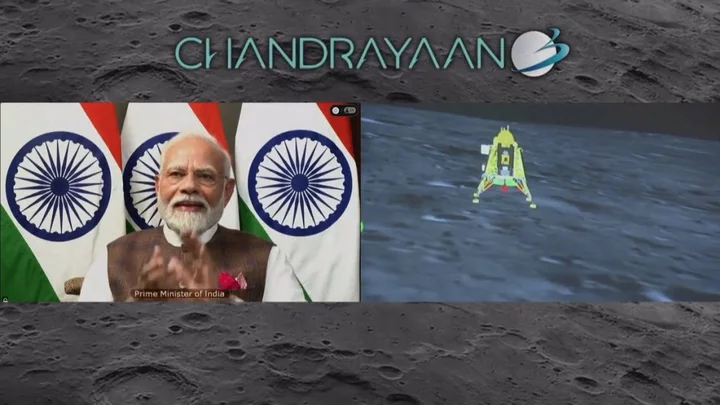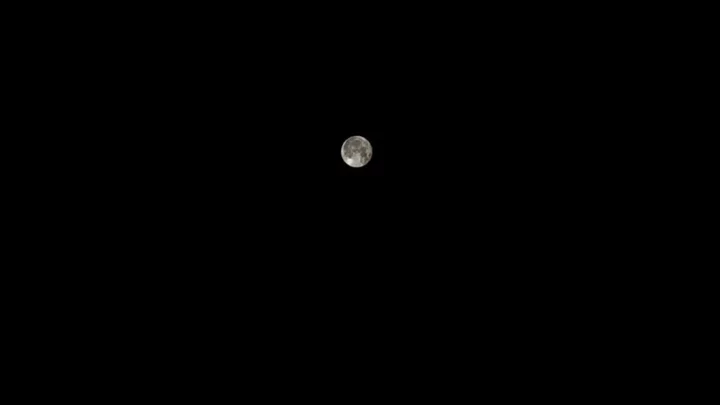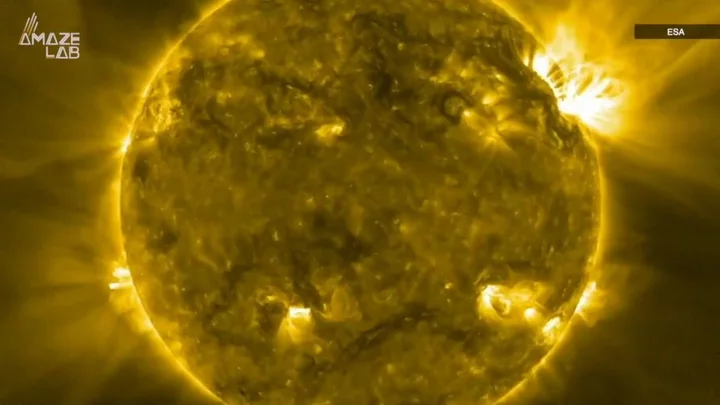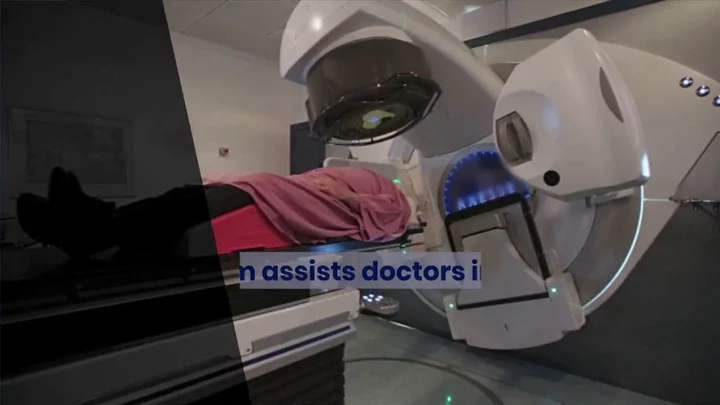
'Hidden structures' discovered deep beneath the dark side of the moon
Scientists have just uncovered billions of years’ worth of secrets buried beneath the surface of the moon. Our celestial companion has been a source of awe and mystery since time immemorial, but now, thanks to China’s space programme, we’re starting to piece together its past. In 2018, the Chang’e-4 lander, of the Chinese National Space Administration (CNSA), became the first spacecraft ever to land on the far side (or the dark side, if you'd prefer) of the moon. Since then, it has been capturing incredible images of impact craters and extracting mineral samples, offering a long-sought insight into the structures that make up the top 1,000 feet of the moon’s surface. Earlier this month, the Chang’e-4’s findings were finally published, and the world was invited to delve deep into the history of our cherished natural satellite. The results, published in the Journal of Geophysical Research: Planets, reveal that the top 130 feet (40m) of the lunar surface are made up of multiple layers of dust, soil, and broken rocks. Hidden within these layers is a crater, which formed when a large object slammed into the moon, according to Jianqing Feng, an astrogeological researcher at the Planetary Science Institute in Tucson, Arizona, who co-led the pioneering analysis. Beneath this, Feng and his colleagues discovered five distinct layers of lunar lava that spread across the landscape billions of years ago. Experts believe that our moon formed 4.51 billion years ago, when a Mars-size object crashed into Earth and broke off a chunk of our planet, as Live Science notes. Over the following 200 million years or so, the moon continued to be pummelled by space debris, with numerous impacts leaving cracks in its surface. Just like on Earth, the moon’s mantle contained pockets of molten magma, which infiltrated the newly formed cracks thanks to a series of volcanic eruptions, Feng explained. However, the new data provided by Chang’e-4 showed that the closer the volcanic rock was to the moon’s surface, the thinner it got. "[The moon] was slowly cooling down and running out of steam in its later volcanic stage," Feng said. "Its energy became weak over time." It is understood that volcanic activity on the moon died out between a billion and 100 million years ago, which means it is largely considered “geologically dead”. However, Feng and his co-authors have suggested there could still be magma buried deep beneath the lunar surface. Chang’e-4 still has much work to do, and Feng and his team hope this is just the beginning of their literally ground-breaking mapping of the moon. Sign up for our free Indy100 weekly newsletter Have your say in our news democracy. Click the upvote icon at the top of the page to help raise this article through the indy100 rankings.
2023-08-23 22:25

Watch: India becomes first country to make historic moon landing on planet's south pole
This is the moment India made its historic first landing on the moon's south pole, just days after Russia's attempt ended in a crash. India's attempt to land its Chandrayaan-2 mission near the south pole in 2019 was unsuccessful, but the Chandrayaan-3 mission went off without a hitch. The lander, known as Vikram, touched down at 13:34 BST. It's thought no attempts have been successful so far because of its rocky landscape, making it difficult to find somewhere to land safely. Sign up to our new free Indy100 weekly newsletter
2023-08-23 20:47

Scientists discover that plants make sounds when hurt that you can hear
Plants make sounds when they’re distressed and humans are only hearing them now for the first time, scientists have found. New research has discovered that sounds are used by plants to communicate with their ecosystems – and they could be studied and used to improve growing conditions for plants in the future. Itzhak Khait of Tel Aviv University led the research, which involved studying tobacco and tomato plants. As the findings showed, the plants made high-frequency noise which could be detected five metres away. The study was published in the journal Cell, and the results “can alter the way we think about the plant kingdom, which has been considered to be almost silent until now”. Not only that, but by studying the sounds emitted by the plants experts could tell whether they were in need of water or suffering from cuts. Lilach Hadany, an evolutionary biologist at Tel Aviv University, told Vice: “We started this project from the evolutionary question: why are plants mute? It appears that plants could have a lot to benefit from acoustic communication.” “We were particularly happy that the sounds turned out to be informative – containing information on the type of the plant and the type of the stress.” The findings could change the way plants are grown and communicate with their environments in future, given that we now know information can be conveyed via the sounds. Hadany went on to say: “What we do know is that there are sounds in the air, and they contain information. “Thus, natural selection may be acting on other organisms (animals and plants) to whom the sounds are relevant, to be able to hear the sounds and interpret them. That includes animals that can hear the sounds and can use the information to choose a food source or a laying site, or potentially plants that can prepare for the stress.” The team said in the study: “Plant sound emissions could offer a way for monitoring crops water and possibly disease states—questions of crucial importance in agriculture. “In times when more and more areas are exposed to drought due to climate change, efficient water use becomes even more critical, for both food security and ecology.” Sign up for our free Indy100 weekly newsletter Have your say in our news democracy. Click the upvote icon at the top of the page to help raise this article through the indy100 rankings.
2023-08-23 19:27

Toilet invented that is so slippy nothing can leave skid marks
A 3-D-printed toilet has been invented and the surface is so slippery that nothing can leave a mark on it. Cleaning the toilet has to be one of the grimmest household chores, but thanks to new material, you may never have to scrub a loo again. The toilet is the invention of Yike Li at Huazhong University of Science and Technology in Wuhan, China, who, alongside colleagues, invented a toilet whose surface is so slippery that nothing stains it and uses less water for each flush. The team created a prototype of the toilet around 10 times smaller than a real one. It was made using 3D printing technology, where particles of plastic and hydrophobic sand grains were fused together with lasers. The surface of the toilet was lubricated with a type of silicon oil that also penetrated the surface due to the complex structure of the material. The team tested the toilet with a variety of substances, including honey, yoghurt, muddy water as well as synthetic faeces. They found that none of the substances stuck to the toilet bowl. Amazingly, the toilet was just as slippery after having been rubbed with sandpaper over 1,000 times, which Li believes is due to the oil being able to penetrate the material of the toilet. Li believes the technology would be suited for settings in which a toilet gets a lot of use, such as on modes of transport and in public toilets. He explained: “The reduced flushing volume would result in less wasted water during transportation to the processing facilities, thereby saving transportation costs.” But, before that can happen, Li says the technology needs to be adapted for use on a full-sized toilet and also needs to be cheaper to make. You can see the toilet in action below courtesy of New Scientist. Nothing can stick to this 3D-printed slippery toilet youtu.be Sign up to our free Indy100 weekly newsletter Have your say in our news democracy. Click the upvote icon at the top of the page to help raise this article through the indy100 rankings.
2023-08-22 20:24

Astronomers are expecting a message from aliens today that is 40 years in the making
Astronomers are hoping to receive a message from aliens after a 40-year wait for a reply comes to an end. On 15 August 1983, a pair of hopeful astronomers at Stanford University beamed a message into space via an antenna. They believe that 22 August 2023 is the earliest time they can expect to receive a reply. The experiment was the brain-child of professors Masaki Morimoto and Hisashi Hirabayashi, who, around 40 years ago, beamed 13 drawings in radio waves to a star named Altair, approximately 16.7 light-years away from Earth. The 13 drawings sent into space by Morimoto and Hirabayashi were designed to tell the story of human evolution and how human beings came to exist on Earth. Drawings depicted how humans evolved from microscopic creatures that eventually moved from water onto land. It also explained our solar system and what DNA is. It was the hope that if there was any intelligent life on planets close to the star, they would interpret the messages and hopefully send a reply. In anticipation of a reply, a team at The University of Hyogo in Japan will monitor for a reply using the Japan Aerospace Exploration Agency’s (JAXA) antenna. Led by Shinya Narusawa, the team will listen for around an hour for signs of unusual radio activity or signals that could suggest a reply. Narusawa explained: “A large number of exoplanets have been detected since the 1990s,” adding, “Altair may have a planet whose environment can sustain life.” Unfortunately, if a reply is received, it will be too late for Morimoto, one of the professors responsible for the original project, after he died in 2010. Dr Hirabayashi, the other pioneer, is currently a professor emeritus at JAXA. It is yet to be seen whether he will see his 40-year experiment gets the conclusion he was hoping for. Sign up to our free Indy100 weekly newsletter Have your say in our news democracy. Click the upvote icon at the top of the page to help raise this article through the indy100 rankings.
2023-08-22 17:24

China discovers 'hidden structures' deep beneath the dark side of the moon
Scientists have just uncovered billions of years’ worth of secrets buried beneath the surface of the moon. Our celestial companion has been a source of awe and mystery since time immemorial, but now, thanks to China’s space programme, we’re starting to piece together its past. In 2018, the Chang’e-4 lander, of the Chinese National Space Administration (CNSA), became the first spacecraft ever to land on the far side (or the dark side, if you'd prefer) of the moon. Since then, it has been capturing incredible images of impact craters and extracting mineral samples, offering a long-sought insight into the structures that make up the top 1,000 feet of the moon’s surface. Earlier this month, the Chang’e-4’s findings were finally published, and the world was invited to delve deep into the history of our cherished natural satellite. The results, published in the Journal of Geophysical Research: Planets, reveal that the top 130 feet (40m) of the lunar surface are made up of multiple layers of dust, soil, and broken rocks. Hidden within these layers is a crater, which formed when a large object slammed into the moon, according to Jianqing Feng, an astrogeological researcher at the Planetary Science Institute in Tucson, Arizona, who co-led the pioneering analysis. Beneath this, Feng and his colleagues discovered five distinct layers of lunar lava that spread across the landscape billions of years ago. Experts believe that our moon formed 4.51 billion years ago, when a Mars-size object crashed into Earth and broke off a chunk of our planet, as Live Science notes. Over the following 200 million years or so, the moon continued to be pummelled by space debris, with numerous impacts leaving cracks in its surface. Just like on Earth, the moon’s mantle contained pockets of molten magma, which infiltrated the newly formed cracks thanks to a series of volcanic eruptions, Feng explained. However, the new data provided by Chang’e-4 showed that the closer the volcanic rock was to the moon’s surface, the thinner it got. "[The moon] was slowly cooling down and running out of steam in its later volcanic stage," Feng said. "Its energy became weak over time." It is understood that volcanic activity on the moon died out between a billion and 100 million years ago, which means it is largely considered “geologically dead”. However, Feng and his co-authors have suggested there could still be magma buried deep beneath the lunar surface. Chang’e-4 still has much work to do, and Feng and his team hope this is just the beginning of their literally ground-breaking mapping of the moon. Sign up for our free Indy100 weekly newsletter Have your say in our news democracy. Click the upvote icon at the top of the page to help raise this article through the indy100 rankings.
2023-08-21 18:54

Why you should delay your first coffee of the morning
For a lot of people, coffee is one of the few things that gets them out of bed and out the door in the mornings. But while it’s tempting to whack the kettle on first thing, a health expert has stated that delaying our first coffee of the day could be much more beneficial to our health. Nutritionist Gabi from The Fast 800 urged people to wait at least 90 minutes before getting their first coffee hit [via the Mirror]. Gabi claims that we can all boost energy levels by doing so. In fact, eating on an empty stomach could even cause your body to enter stress mode and release hormones like adrenaline and cortisol. "Supporting your morning coffee routine with some smart practices can be a game changer for your overall well-being,” Gabi said. She recommends drinking water, as well as eating a meal packed with fibre and protein to balance sugar levels. “Elevated blood sugar can trigger inflammation and set us up to be on a blood sugar roller coaster for the rest of the day, thereby tanking our energy supply,” the health guru said. "Within the first hour of waking, our cortisol levels ideally acutely rise and fall in a response known as our cortisol awakening response. This rise and fall of cortisol represents a healthy nervous system and actually has a big influence on our immune health and even the risk of autoimmune development." She also states that delaying coffee for a minimum of 90 minutes promotes high energy levels. Gabi said: "Morning light exposure is a huge regulator of circadian rhythm and light exposure triggers the healthy release of cortisol in the morning to support the body’s natural rhythm. Getting natural light exposure within the first hour or so of waking is a great way to support optimal hormone balance." It comes after it was revealed that the drink also gives us an extra ‘special boost’ as well as just a caffeine hit. Scientists have claimed that the act of drinking a cup of joe gives the body a lift, making us more alert, which can’t be replicated merely with caffeine. Sign up for our free Indy100 weekly newsletter Have your say in our news democracy. Click the upvote icon at the top of the page to help raise this article through the indy100 rankings.
2023-08-21 17:18

Study finds that divorced diabetic men have higher risk of amputation
Divorced men with diabetes are at the highest risk of having some or all of their feet and legs amputated because of it, research has found. According to a study of almost 67,000 people with diabetes in Sweden, people with the condition who are divorced are 67 per cent more likely to have to undergo a lower limb amputation than those who are married. Meanwhile men are at 57 per cent greater risk than women. On average, 184 people a week in England have some part of a lower limb removed surgically to stop infection spreading and killing them. Lasantha Wijesinghe, a consultant vascular surgeon in England who performs lower limb amputations, said they were usually necessary because the person’s life was at risk because of sepsis. The authors of the study, which has not been peer-reviewed yet, said they could not be sure why divorcees of both sexes ran such a greater risk than married people, but speculated that this “may be due to a change in self-care and food habits observed in people when they divorce and are more likely to be living alone”. “Specifically with men, this is often related to more social isolation, with a secondary effect of low physical activity,” they added. Older people are also at higher risk of an amputation and patients who are on insulin treatment, have a pre-existing foot condition such as neuropathy or who smoke are also at higher risk. The study also concluded that obese people have a lower risk than those with a standard weight. The authors could not explain this finding but suggested it could be down to chance. Dr Faye Riley, the research communications manager at Diabetes UK, said: “This study identifies a range of factors that may be linked with a higher risk of amputation among people with diabetes, and raises interesting questions about how social support can influence our health behaviours and outcomes. By pinpointing which people with diabetes are most at risk, support can be targeted where it’s most needed.” Sign up to our free Indy100 weekly newsletter Have your say in our news democracy. Click the upvote icon at the top of the page to help raise this article through the indy100 rankings.
2023-08-18 18:45

Tsunamis 3 times the size of the sun 'could disintegrate' Earth
Scientists have detected huge waves in outer space that measure three times the size of our sun. The waves are being formed on a star system called MACHO 80.7443.1718, found around 169,000 light-years from Earth in the Large Magellanic Cloud. The waves are formed in a similar way to waves on Earth. Just like ones on our planet are formed due to the gravitational pull of the moon, a nearby celestial object stretches the star and causes enormous waves in the system MACHO 80.7443.1718. Experts have studied the star’s unusual behaviour and published a paper in the journal Nature Astronomy. The experts stated that MACHO 80.7443.1718 contains a "heartbreak" star, which is a term they use to describe the way plasma is influenced by the pull of a nearby object to unleash incredible waves of energy. The sheer power of these waves is, itself, difficult to imagine. In fact, just one of them would end life on Earth in an instant. "Each crash of the star’s towering tidal waves releases enough energy to disintegrate our entire planet several hundred times over," MacLeod said. "This heartbreak star could just be the first of a growing class of astronomical objects," MacLeod added. "We’re already planning a search for more heartbreak stars, looking for the glowing atmospheres flung off by their breaking waves." The scale in general is far beyond human comprehension – at least ours, anyway. In fact, the waves of plasma measure around 2.5 million miles above the surface of the primary star – which itself has a radius of 10.4 million miles, around 24 times the size of the sun. Sign up to our free Indy100 weekly newsletter Have your say in our news democracy. Click the upvote icon at the top of the page to help raise this article through the indy100 rankings.
2023-08-17 20:50

Man's legs turn purple in rare Covid complication
The effects of long Covid are still being uncovered by experts, and now doctors have been studying a rare complication that saw a man’s legs turn purple. A new research paper has been released which looks into the case of a 33-year-old man who had been infected with Covid 18 months earlier and experienced difficulties when standing up. His legs would turn purple when he did so, as well as tingling and itching, but things would return to normal when he lay down. The odd condition was diagnosed as POTS dysautonomia. This was determined after his pulse was found to rise to 127 beats per minute when standing, as well as feeling shaky and unsteady on his feet. The paper leads on from previous studies, which detected POTS in 20 people after they developed a Covid-19 infection. According to the new study published in The Lancet, there is "evidence is growing of a link between long Covid and POTS dysautonomia”. The paper’s co-author Dr Manoj Sivan said in a statement: "This was a striking case of acrocyanosis in a patient who had not experienced it before his Covid-19 infection. "Patients experiencing this may not be aware that it can be a symptom of long Covid and dysautonomia and may feel concerned about what they are seeing. Similarly, clinicians may not be aware of the link between acrocyanosis and long Covid." Dr Sivan added: "We need to ensure that there is more awareness of dysautonomia in long Covid so that clinicians have the tools they need to manage patients appropriately." Sign up to our free Indy100 weekly newsletter Have your say in our news democracy. Click the upvote icon at the top of the page to help raise this article through the indy100 rankings.
2023-08-17 17:00

Experts have pinpointed exactly when society will collapse
A prediction about when society is most likely to collapse, made by scientists in the 1970s, has resurfaced – and it looks pretty bleak. Scientists at the Massachusetts Institute of Technology (MIT) used a computer to model patterns like population, natural resources and energy usage. The study, published by Club of Rome, picked out when these factors could hit “limits to growth”, which they said could lead to the downfall of modern life as we know it. They think we’ve got fewer than two decades left, with collapse due in 2040. Gulp. Sign up to our free Indy100 weekly newsletter At the time, the report wasn’t given much credence. But a similar study was carried out in 2009, and came up with similar results. Published by American Scientist, the more recent study found that the model’s results were “almost exactly on course”. "It is important to recognise that its predictions have not been invalidated and in fact seem quite on target. We are not aware of any model made by economists that is as accurate over such a long time span," the study said. And to make matters worse, Dutch sustainability researcher Gaya Herrington concurred with the prediction in 2021. Speaking to The Guardian, Herrington said: “From a research perspective, I felt a data check of a decades-old model against empirical observations would be an interesting exercise.” Herrington found that data aligned with the predictions made back in 1972, which had a worse case scenario of economic growth coming to halt at the end of this decade, and collapse around 10 years later. Thankfully, there was a reason to be cheerful too. She added: “The key finding of my study is that we still have a choice to align with a scenario that does not end in collapse. "With innovation in business, along with new developments by governments and civil society, continuing to update the model provides another perspective on the challenges and opportunities we have to create a more sustainable world.” Have your say in our news democracy. Click the upvote icon at the top of the page to help raise this article through the indy100 rankings.
2023-08-14 19:19

AI could soon be used to treat cancer in the NHS
Artificial intelligence could soon be used to perform radiotherapy to treat certain cancers for the first time. Draft guidance from the National Institute for Health and Care Excellence (Nice) has given approval to nine AI technologies for performing external beam radiotherapy in lung, prostate and colorectal cancers, which could save radiographers hundreds of thousands of hours and help relieve pressure on radiotherapy departments. Currently therapeutic radiographers outline healthy organs on digital images of a CT or MRI scan by hand so that the radiotherapy does not damage healthy cells by minimising the dose to normal tissue. Nice found that using AI to create the contours could free up between three and 80 minutes of radiographers’ time for each treatment plan, and that AI-generated contours were of a similar quality to manually drawn ones. Nice said that the contours would still be reviewed by a trained healthcare professional. It comes after a study found AI was safe to use in breast cancer screenings with evidence growing that it can be more effective in detecting cancers. Sign up to our free Indy100 weekly newsletter Meanwhile, Nice said it was also examining the evidence for using AI in stroke and chest scans. Dr Sarah Byron, the programme director for health technologies at Nice, said using AI could help reduce waiting lists. She added: “NHS colleagues working on the frontline in radiotherapy departments are under severe pressure with thousands of people waiting for scans. “The role imaging plays in radiotherapy treatment planning is quite pivotal, so recommending the use of AI technologies to help support treatment planning alongside clinical oversight by a trained healthcare professional could save both time and money. “We will continue to focus on what matters most and the recommendations made by our independent committee can help to bring waiting lists down for those needing radiotherapy treatment.” The health secretary, Steve Barclay, welcomed the announcement. He said: “It’s hugely encouraging to see the first positive recommendation for AI technologies from a Nice committee, as I’ve been clear the NHS must embrace innovation to keep fit for the future. “These tools have the potential to improve efficiency and save clinicians thousands of hours of time that can be spent on patient care. Smart use of tech is a key part of our NHS long-term workforce plan, and we’re establishing an expert group to work through what skills and training NHS staff may need to make best use of AI.” Charlotte Beardmore, the executive director of professional policy at the Society of Radiographers, welcomed the draft guidance but said it was not a replacement for staff and caution was needed. “It is critical there is evidence to underpin the safe application of AI in this clinical setting,” she said. Using AI would still require input by a therapeutic radiographer or another member of the oncology multi-professional team, she added. “Investment in the growth of the radiography workforce remains critical.” Science is pretty amazing. Have your say in our news democracy. Click the upvote icon at the top of the page to help raise this article through the indy100 rankings.
2023-08-11 18:21
